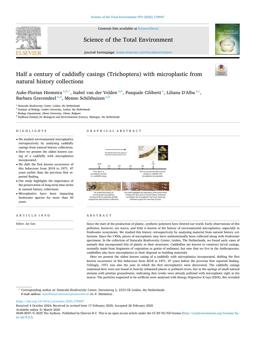2025-03-31
Half a century of caddisfly casings (Trichoptera) with microplastic from natural history collections
Publication
Publication
Science of The Total Environment , Volume 974 - Issue 178947
Since the start of the production of plastic, synthetic polymers have littered our world. Early observations of this pollution, however, are scarce, and little is known of the history of environmental microplastics, especially in freshwater ecosystems. We studied this history retrospectively by analysing material from natural history collections. Since the 1950s, pieces of microplastic may have unintentionally been collected along with freshwater specimens. In the collection of Naturalis Biodiversity Center, Leiden, The Netherlands, we found early cases of animals that incorporated bits of plastic in their structures. Caddisflies are known to construct larval casings, normally made from fragments of vegetation or grains of sediment, but now that we live in the Anthropocene, caddisflies also have microplastics at their disposal as building materials. Here we present the oldest known casing of a caddisfly with microplastics incorporated, shifting the first known occurrence of this behaviour from 2018 to 1971, 47 years before the previous first reported finding. Tellingly, 1971 was also the year in which the first microplastics were discovered. The caddisfly casings examined here were not found in heavily urbanised places or polluted rivers, but in the springs of small natural streams with pristine groundwater, indicating that creeks were already polluted with microplastic right at the source. The particles suspected to be artificial were analysed with Energy Dispersive X-rays (EDX); this revealed titanium, barium, sulphur, zinc, chlorine, and lead – an elemental composition of common plastic additives in agreement with what has been previously reported for microplastics. Our study highlights the importance of the preservation of long-term time series in natural history collections and implies that microplastics have been impacting freshwater species for more than 50 years, and continue to do so on an increasing scale, as the amount of produced plastic keeps rising.
| Additional Metadata | |
|---|---|
| doi.org/10.1016/j.scitotenv.2025.178947 | |
| Science of The Total Environment | |
| Released under the CC BY-NC-ND 4.0 (“Attribution-NonCommercial-NoDerivs 4.0 International”) Licence | |
| Organisation | Staff publications |
|
Hiemstra, A.-F., van der Velden, I., Ciliberti, P., D'Alba, L., Gravendeel, B., & Schilthuizen, M. (2025). Half a century of caddisfly casings (Trichoptera) with microplastic from natural history collections. Science of The Total Environment, 974(178947). doi:10.1016/j.scitotenv.2025.178947 |
|
